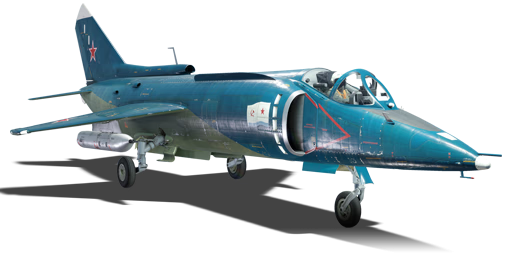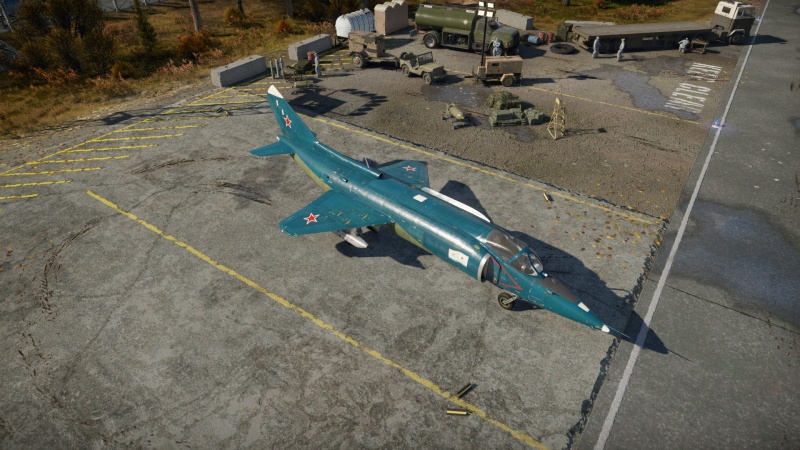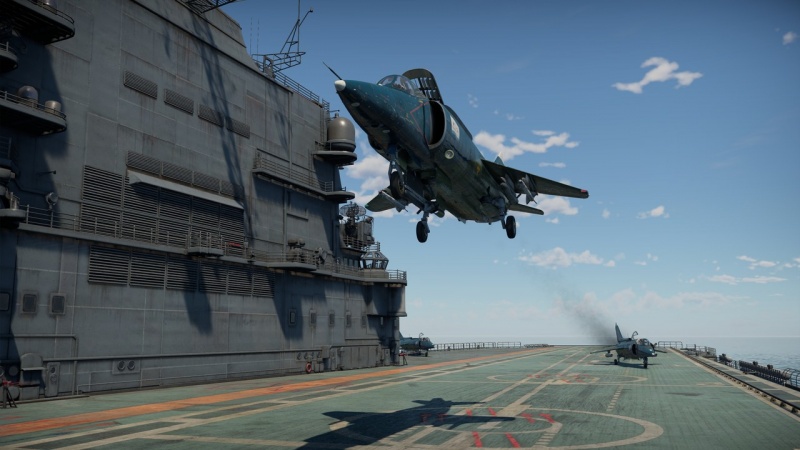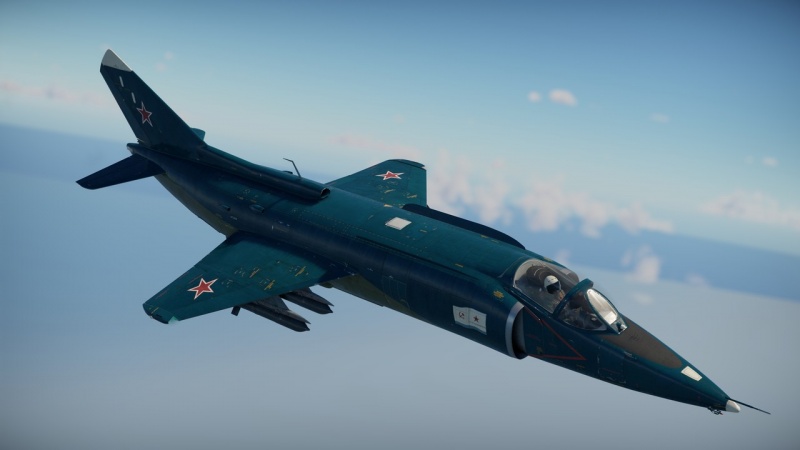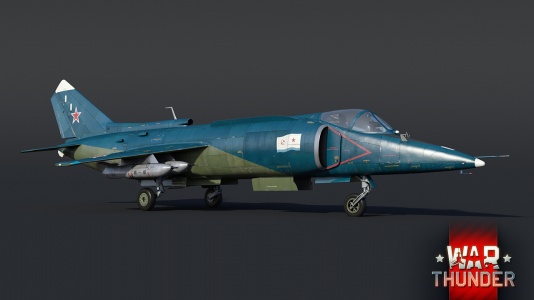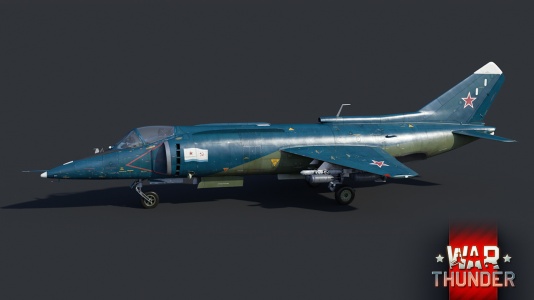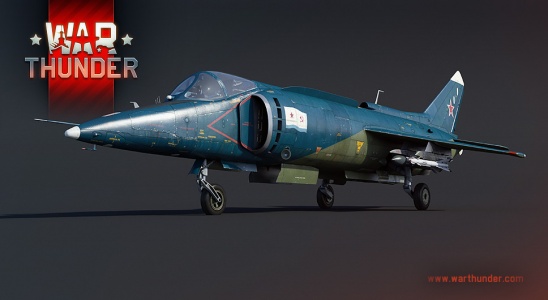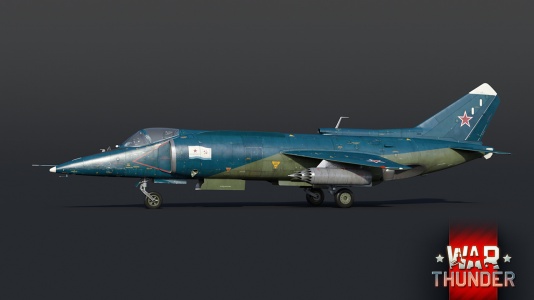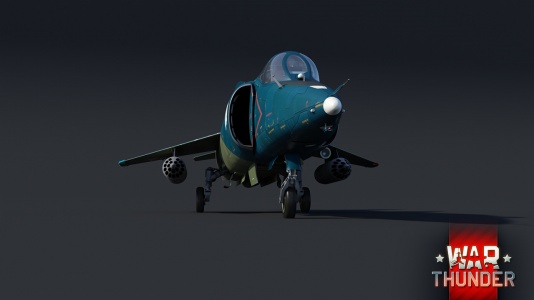Yak-38
| This page is about the Russian premium naval jet fighter Yak-38. For the regular version, see Yak-38M. |
Contents
Description
The Yak-38 is a premium gift rank VI Soviet naval jet fighter with a battle rating of 9.3 (AB/RB/SB). It was introduced in Update "New Power".
is also a VTOL aircraft.
General info
Flight performance
| Characteristics | Max Speed (km/h at 0 m - sea level) |
Max altitude (metres) |
Turn time (seconds) |
Rate of climb (metres/second) |
Take-off run (metres) | |||
|---|---|---|---|---|---|---|---|---|
| AB | RB | AB | RB | AB | RB | |||
| Stock | 1,190 | 1,186 | 12500 | 40.0 | 41.2 | 77.4 | 70.5 | 520 |
| Upgraded | 1,207 | 1,199 | 37.3 | 38.6 | 113.1 | 94.3 | ||
Details
| Features | |||||
|---|---|---|---|---|---|
| Combat flaps | Take-off flaps | Landing flaps | Air brakes | Arrestor gear | Drogue chute |
| X | ✓ | ✓ | X | X | ✓ |
| Limits | ||||||
|---|---|---|---|---|---|---|
| Wings (km/h) | Gear (km/h) | Flaps (km/h) | Max Static G | |||
| Combat | Take-off | Landing | + | - | ||
| 1265 | 500 | N/A | 650 | 500 | ~12 | ~5 |
| Optimal velocities (km/h) | |||
|---|---|---|---|
| Ailerons | Rudder | Elevators | Radiator |
| < 650 | < 850 | < 920 | N/A |
Engine performance
| Engine | Aircraft mass | |||||
|---|---|---|---|---|---|---|
| Engine name | Number | Basic Mass | Wing loading (full fuel) | |||
| Tumansky R-27V-300 (main) | 1 | 6,645 kg | 502 kg/m2 | |||
| RD-36-35FV (lift jets) | 2 | |||||
| Engine characteristics | Mass with fuel (no weapons load) | Max Takeoff Weight | ||||
| Weight (each) | Type | 7m fuel | 20m fuel | 23m fuel | ||
| 1,350 kg (main) | Vectored-thrust low-bypass turbofan | 7,482 kg | 9,036 kg | 9,395 kg | 10,300 kg | |
| 198 kg (lift jet) | Axial-flow turbojet | |||||
| Maximum main engine thrust @ 0 m (RB / SB) | Thrust to weight ratio in forward flight @ 0 m (100%) | |||||
| Condition | 100% | WEP | 7m fuel | 20m fuel | 23m fuel | MTOW |
| Stationary | 6,600 kgf | N/A | 0.88 | 0.73 | 0.70 | 0.64 |
| Optimal | 6,600 kgf (0 km/h) |
N/A | 0.88 | 0.73 | 0.70 | 0.64 |
| Maximum lift engine thrust @ 0 m (RB / SB) | Thrust to weight ratio in VTOL (all 3 engines) @ 0 m (100%) | |||||
| Stationary | 2,840 kgf | N/A | 1.56 | 1.29 | 1.24 | 1.13 |
Survivability and armour
The Yak-38 has no armour. It is a fairly large target with the entire fuselage being taken up with engines and fuel tanks.
Modifications and economy
Armaments
Offensive armament
The Yak-38 is armed with:
- A choice between two presets:
- Without offensive armament
- 1 x 23 mm VSPU-36 ventral gun pod containing a GSh-23L cannon (160 rpg)
Suspended armament
The Yak-38 can be outfitted with the following ordnance:
- 2 x 23 mm GSh-23L cannons (250 rpg = 500 total)
- 4 x 23 mm GSh-23L cannons (250 rpg = 1,000 total)
- 10 x 100 kg OFAB-100 bombs (1,000 kg total)
- 2 x 250 kg OFAB-250sv bombs (500 kg total)
- 4 x 250 kg OFAB-250sv bombs (1,000 kg total)
- 2 x 500 kg FAB-500M-54 bombs (1,000 kg total)
- 2 x 500 kg FAB-500M-54 bombs + 2 x 250 kg OFAB-250sv bombs (1,500 kg total)
- 64 x S-5KP rockets
- 64 x S-5KP rockets
- 96 x S-5KP rockets
- 40 x S-8M rockets
- 2 x S-24B rockets
- 4 x S-24B rockets
- 32 x S-5KP rockets + 2 x S-24B rockets
- 2 x R-60 missiles
- 2 x R-60 missiles + 2 x 100 kg OFAB-100 bombs (200 kg total)
- 2 x R-60 missiles + 2 x 250 kg OFAB-250sv bombs (500 kg total)
- 2 x R-60 missiles + 32 x S-5KP rockets
- 2 x R-60 missiles + 2 x S-24B rockets
- 2 x Kh-23M missiles + 1 "Delta" guidance pod
Usage in battles
The Yak-38 is one of the most versatile aircraft in the Russian tech tree as it has sufficient armament for all sorts of engagements: air-to-air, air-to-ground, air-to-sea. Thanks to its VTOL capabilities, it is able to achieve a "helicopter" playstyle if needed.
When in air battles:
The Yak-38 has an impressive sort of armaments for all engagements when in air battles. It can be used as a standard fighter with gun pods, ground units destroyer with gun pods, rockets, missiles and bombs or as a missile fighter with its potent R-60 air-to-air missiles.
As a fighter:
The Yak-38 has access to up to 4 rapid fire 23 mm gun pods, capable of becoming one of the most armed aircrafts when in a gun-to-gun dogfight. They are also capable of destroying ground units such as artillery, anti-air emplacements, armoured vehicles and even light armoured vessels such as cargo ships. It has also access to 2 R-60 air-to-air infrared guided missiles. This missiles are able to lock and engage an enemy up to 8 km away, perfect for long range engagements against unaware pilots. It should be noted that the Yak-38 is only able to carry only 2 of said missiles and they cannot be equipped with gunpods, potentially reducing its anti-air capabilities.
As a ground striker:
The ground ordnance on the Yak-38 leaves nothing to be desired, it carries a vast array of bomb, rockets and missiles loads which can be taken according to the situation. It has access to S-5KP unguided rockets which can be used against pillboxes, armoured vehicles such as tanks, enemy vessels such as destroyers and even enemy bases (not recommended as the TNT equivalent is really low compared to bombs). It has access to CCIP ballistic computer which make the aiming of suspended ordnance a really easy task when doing CAS strikes.
As a bomber:
Thanks to the bomb payload the Yak-38 carries, it is able to act as a low level lightning strike bomber (flying close to the ground as fast as possible) although it is not recommended as the low payload it carries is not enough to take a single base completely (2 x 500 kg bombs). Playing as a bomber is not recommended in terms of cost-benefit but it is up to pilot's discretion.
When in ground battles:
This is the place where the Yak-38 shines, specially for an unusual suspended ordnance which can be exploited to its max, the Kh-23M beam-riding guided missile. Different from air-to-ground missiles like the Bullpups and Nords, the Kh-23M is mouse guided and not manually guided (meaning it follows the cursor and not inputs placed by keys like on manually guided missiles). Despite only being able to carry 2 of this missiles, each missile can be a kill if used correctly. It is recommended to use them in a top attack preferably at an azimuth greater than 35° from the target so that the missile has clear line-of-sight with zero obstructions (fences, trees, buildings, etc) and is able to penetrate the roof as it has a really low armour penetration (97 mm of penetration at 0° in all ranges). The missile is able to be fired at a 10 km range from the target although it is not recommended to do so unless the pilot has really smooth mouse settings for small and accurate movements. Besides the Kh-23M, the Yak-38 has access to bombs and rockets which can be used with the ballistic computer to make pinpoint accuracy attacks on enemy targets. It is up to pilot's discretion to decide the suspended ordnance carried.
Pros and cons
Pros:
- VTOL capability
- Fast acceleration - one of the fastest subsonic jets, can quickly hit Mach 0.98 quickly in level flight!
- Plenty of payload options (20 setups)
- Has access to the very efficient S-24B rockets and Kh-23M AGMs, as well as R-60 AAMs
- CCIP for its guns and rockets mean you can easily target enemy ground units - S-24B rockets are especially effective
Cons:
- Subsonic
- Cannot use thrust vectoring in cruise flight or combat, unlike the Harriers - nozzles and lift engines automatically disengage at cruise speed
- No airbrakes, can be difficult to bleed enough speed for a regular landing, though it can use its VTOL engines as an airbrake once slower than 500 km/h
- Vertical landings require careful consideration of your velocity bleed.
- Somewhat fragile gear means careless landings can cause the plane to smash into the strip or carrier deck
- Very high RPM combined with low RPG count means you have to be very careful when using the gun(s)
History
Devblog
Although Soviet engineers were experimenting with VTOL fixed wing aircraft design since the early 1960's, it wasn't until December 1967 before a formal order to develop a light VTOL strike aircraft as well as a corresponding trainer version was issued. As a result, engineers at the Yakovlev design bureau began work on the new aircraft in the late 1960's, basing their design on experience gained from developing the preceding Yak-36 - an early VTOL demonstration design.
The new aircraft, designated Yak-36M, was being developed for immediate frontline service, operating both from land bases as well as aircraft-carrying ships. The aircraft's primary role was that of a strike aircraft, engaging ground and surface targets while also being suited to intercept enemy aircraft and helicopters if necessary.
Not too long after work on the project began, the first prototype saw completion and conducted its maiden flight in December 1970. Subsequent prototypes and trials continued testing the aircraft's performance, particularly its novel VTOL capabilities. By 1973, the aircraft was considered ready and serial production commenced.
After some further testing and crew training, the aircraft officially entered service with the Soviet Navy in August 1977, receiving the designation Yak-38. By 1982, over 140 Yak-38's were built, all of which served aboard the then new Kiev-class aircraft carriers. In the mid 1980's, the modernized Yak-38M version came into service, most prominently featuring more powerful engines as well as other improvements. About 50 Yak-38M's were built before the type was ultimately decommissioned in 1991.
Media
- Skins
- Images
- Yak-38 Devblog Images
- Videos
See also
External links
| USSR jet aircraft | |
|---|---|
| Bereznyak-Isayev | BI |
| Yakovlev | Yak-15 · Yak-15P · Yak-17 · Yak-23 · Yak-28B · Yak-30D · Yak-38 · Yak-38M · Yak-141 |
| Mikoyan-Gurevich | MiG-9 · MiG-9 (l) · MiG-15 · MiG-15bis · MiG-15bis ISh · MiG-17 · MiG-17AS · MiG-19PT |
| MiG-21F-13 · MiG-21PFM · MiG-21S (R-13-300) · MiG-21SMT · MiG-21bis | |
| MiG-23M · MiG-23ML · MiG-23MLD · MiG-27M · MiG-27K | |
| MiG-29 · MiG-29SMT | |
| Lavochkin | La-174 · La-15 · La-200 |
| Sukhoi | Su-9 · Su-11 |
| Su-7B · Su-7BKL · Su-7BMK · Su-17M2 · Su-17M4 · Su-22M3 | |
| Su-24M | |
| Su-25 · Su-25BM · Su-25K · Su-25T · Su-25SM3 · Su-39 | |
| Su-27 · Su-27SM | |
| Su-34 | |
| Ilyushin | IL-28 · IL-28Sh |
| Tupolev | Tu-14T |
| USSR premium aircraft | |
|---|---|
| Fighters | Krasnolutsky's I-15bis · I-16 type 28 · Zhukovsky's I-153-M62 · I-153P · I-180S · I-301 · ITP (M-1) |
| LaGG-3-4 · LaGG-3-23 · LaGG-3-34 · Dolgushin's La-7 · La-11 | |
| Eremin's Yak-3(e) · Yak-3 (VK-107) · Yak-3T · Golovachev's Yak-9M | |
| ▂P-39K-1 · ▂Pokryshkin's P-39N-0 · ▂P-39Q-15 · ▂P-40E-1 · ▂P-47D-27 · ▂P-63A-5 · ▂P-63A-10 · ▂P-63C-5 | |
| ▂Hurricane Mk IIB · ▂Spitfire Mk IXc · ▂Fw 190 D-9 | |
| Twin-engine fighters | I-29 |
| Jet fighters | Su-11 · MiG-15bis ISh · MiG-17AS · MiG-21S (R-13-300) · MiG-23ML |
| Strike aircraft | IL-2M "Avenger" · IL-2 M-82 · IL-8 (1944) · Su-6 · Tandem MAI · TIS MA · Su-8 · Tu-1 |
| Yak-38 · Su-7BMK · Su-25K · Su-39 | |
| Bombers | Po-2M · Be-6 · MBR-2-M-34 · Pe-2-205 · TB-3M-17-32 |
| ▂PBY-5A Catalina · ▂Hampden TB Mk I · ▂A-20G-30 · ▂B-25J-30 | |


